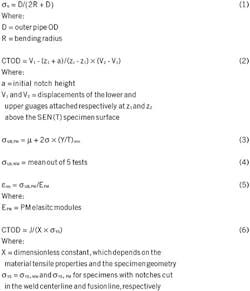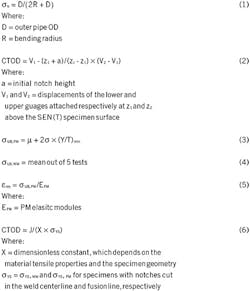Sensitivity studies suggest toughness is often more critical than strength in subsea pipeline welds, especially narrow-bevel mechanized welds. Choosing consumables and welding parameters to achieve high toughness, therefore, is helpful, even if at the expense of strength. The strength of weld metal consumables depends on the choice of consumable and welding technique. Alloy 686-based consumable usually gives higher strength but lower toughness than Alloy 625-based consumable.
DNV-OS-F101 specifies maximum allowable ductile tearing during reeled installation. No such requirements are specified, however, for a pipeline in-service. This may be unnecessary for carbon steel pipes, but clear guidance should exist for clad pipelines.
Inconsistency also exists between the lateral buckling assessment, for which the lower-bound tensile properties are normally assumed, and the strain-controlled engineering critical assessment (ECA), with the upper-bound tensile properties assumed. This inconsistent approach may lead to unnecessary conservatism. The lateral buckling and strain-controlled ECA assessments should instead use the same inputs in terms of tensile flow behavior.
View Image Gallery>>
Background
There is increasing demand for subsea pipelines conveying corrosive constituents. Clad pipe is an alternative to chromium stainless steel pipe (e.g., 13%, 22%, or 25% Cr), routinely used for subsea pipelines. Clad pipe has a thin internal layer of corrosion-resistant alloy (CRA),1 2 such as 316L, 825, or 625, metallurgically bonded to the carbon steel (CS) pipe and increasing its strength.3
Choosing between chromium and clad pipes requires considering cost, availability, and fluid compatibility. Clad pipe has found application for pipelines conveying highly corrosive fluids or those at risk of hydrogen-induced stress cracking. It is also used for high-temperature subsea pipelines and steel catenary risers because its strength is not significantly reduced at elevated temperatures and it has excellent fatigue performance in sour environments.1 4
Reeled clad pipe has never been used for deepwater pipelines designed for lateral bucking with high plastic deformation in-service. All subsea clad pipelines installed to date consist of hot roll-bonded (HRB) clad plates cold formed into pipes and longitudinally welded at the pipe mill. Double-sided longitudinal welding-external with a CS consumable and internal with a CRA consumable-avoids back purging and provides similar mechanical (backing steel) and corrosion resistance (CRA clad) properties compared with those of a parent clad plate.
Fig. 1a shows typical geometry of a seam weld bevel and a welding sequence. Girth welding is used to assemble a pipeline. In contrast to seam welding, it is generally impractical to apply double-sided girth welding in a spoolbase setup. Clad pipelines therefore are welded from the outside with a consumable suitable for welding dissimilar materials. Adequate mechanical and corrosion-resistance properties are ensured by the use of nickel-based consumables with enhanced corrosion performance. Fig. 1b shows typical geometry of a mechanized girth weld bevel and welding sequence.
Reeling is a cost-efficient alternative to S-lay and J-lay methods for installation of subsea pipelines up to 18-in. OD.5 In addition to faster installation, the quality of reeled pipeline construction is enhanced by onshore welding and inspection under controlled conditions. A reeling operation induces at least two plastic strain cycles in the pipeline. Equation 1 calculates bending strain, εb, typically on the order of 1-2%.
The pipeline may be clamped during unreeling to allow for including an intermediate structure. When clamped, the pipeline is subject to high cyclic stresses below the clamp. Deepwater pipelines are not trenched and therefore may be subjected to lateral buckling during operation. After the initial lateral buckle occurs, they are usually subjected to cyclic loading due to varying operational conditions.
DNV offshore standard DNV-OS-F101 requires that ECA and automated ultrasonic testing (AUT) occur on all subsea pipelines undergoing 0.4% strain or more during installation or in-service.1 In practice all reeled pipelines designed to DNV must be subjected to AUT. Defect acceptance criteria at a fabrication stage are determined with ECA.
Nickel-based consumables are denser and have a coarser grain structure than CS, which makes AUT difficult. Combined with a stringent visual inspection of the weld root, this characteristic makes the repair rate for clad pipelines higher than that for conventional CS pipelines. In this article the authors discuss the problems associated with AUT and ECA during a recent deepwater project involving more than 50 km of 8-in. and 10-in. OD reeled clad pipelines, some of which were subjected to controlled lateral buckling in-service.
View Image Gallery>>
Welding qualification
Girth welds are usually the most critical part of a pipeline and require adequate mechanical and corrosion-resistance properties. A welding procedure qualification (WPQ) program qualifies welding procedure specifications (WPS) proposed for production welding. There are several WPS for a typical reeled pipeline, including: mainline, onshore-offshore, tie-in-cutout, and pipe-to-end termination with the associated repair WPS.
Welded coupons produced for each WPS from project-specific pipe material are nondestructively examined and mechanically tested at a certified laboratory according to the agreed specification. Successful testing allows finalization of the WPSs with associated procedure qualification records (PQR), inclusive of all welding records of tested coupons, for fully traceable use in production.
View Image Gallery>>
Non-destructive examination
Fig. 2 shows the root, fill, and cap weld regions. There are typically three different materials in the clad pipe weld region:
• Fine-grained isotropic backing steel.
• Fine-grained but anisotropic clad material (alloy 316L in this article).
• Coarse-grained and strongly anisotropic dendritic nickel-based alloy weld.
Although AUT using shear waves could inspect fusion line defects, their penetrating power is insufficient for inspecting defects in the weld stemming from any significant sound attenuation in the coarse grained weld material. In contrast to the uniformity of regular CS pipelines, sound velocity in various clad pipeline areas (backing steel, weld, and clad) differs. The anisotropy of the clad and weld materials also leads to too much scatter, resulting in an unacceptable signal-to-noise ratio.
Conventional AUT methods, therefore, using shear-wave reflection, are not applicable on their own for inspection of clad pipelines. Longitudinal waves have a better penetrating power and give an acceptable signal-to-noise ratio. Transmitter-receiver longitudinal (TRL) probes combined with time-of-flight reflection (TOF(R)), using the sound diffraction and reflection, therefore were used. TOF(R) obtains additional information about flaws in the root and hot weld passes. This combined approach, however, leaves the weld cap region not fully inspected due to probe set-up and weld bevel geometry. Additional creep-wave probes, therefore, were used for inspection of this inaccessible zone near the pipe's outer surface.
The clad pipe weld root must be free from critical defects that might compromise a corrosion barrier required for conveying corrosive fluids. In addition to AUT, visual inspection of the internal pipe surface looked for surface breaking defects such as lack of root penetration, burn through, and excessive discoloration, using a high-definition video camera with a built-in laser for sizing misalignment (hi-lo), root concavity, and root penetration.
View Image Gallery>>
AUT qualification
An adopted AUT approach must guarantee adequate flaw detection and sizing accuracy, which can be combined into a rejection criterion. AUT qualification involves repeatability, temperature sensitivity, and detection ability and sizing accuracy test programs. The repeatability test ensures that the AUT system performs consistently. A calibration block is scanned several times and the readings are compared. Differences between readings taken at different times must be within the limit specified in the applicable code.
The temperature sensitivity test ensures that temperature does not affect sound propagation and detection-rejection capability. Welded coupons and calibration block welds, at both room and elevated temperatures, are scanned and the readings compared. Differences between readings must be within the limit specified in the applicable code.
The detection ability and sizing accuracy test needs to be improved on natural defects representative of the actual production. It is simply impractical to produce enough natural defects in the project timescale. The variation of welding parameters, mechanical aids, or electrical discharged machining is used to create artificial but realistic defects. Welds containing seeded defects are scanned and macro-sliced. The AUT readings are compared with the measured flaw dimensions. The obtained information is analyzed per Nordtest NT Technical Report 394 to determine the probability of detection (PoD) or probability of rejection (PoR) curves.6
Essential variables such as welding procedure, bevel geometry, transducer set-up, AUT system, data acquisition, and data treatment go into making a decision about qualification. Because the AUT system selected for this project was not pre-qualified for that particular set of essential variables, a full AUT qualification was carried out for the J and V-bevel weld configurations (mechanized mainline and manual tie-in-cutout welding, respectively). Developing the PoR curves used a total of 25 welds with 215 seeded and natural defects for the J-bevel configuration and more than 1,500 macrographs were examined. In addition, 20 welds with 131 seeded and natural defects were made and more than 1,400 macrographs taken for examination for the V-bevel configuration.
The overall program, from the initial welding of test welds to the final approval of qualification document, took more than 1 year and confirmed that the AUT inspection of clad pipelines was difficult. The main issue was significant oversizing, especially for root indications. Combined with stringent acceptance criteria for root defects, this inspection difficulty led to a higher repair rate than for regular carbon steel pipelines.
View Image Gallery>>
Pipe fitment
Clad pipe specifications generally require that internal hi-lo does not exceed 1 mm. Large contact loads, exerted by a press brake during cold forming of HRB clad plates into pipes, may lead to poor dimensional tolerances of the internal clad-pipe diameter. This makes achieving a hi-lo of <1 mm difficult when assembling clad pipelines. Laser measuring all clad pipe ends at the coating yard before production welding improved fitment. Analysis of each joint before placement on the production line sought optimum rotation position with respect to the previous joint, minimizing misalignment.
Finding a rotation angle with a hi-lo of <1 mm prompted clear marking of the optimum rotational position to allow a timely fit-up. Otherwise the next pipe joint on the rack was assessed until a suitable joint was found. This approach required the presence of qualified fitting operators for the whole welding process and additional logistic arrangements at the spoolbase to move pipe joints.
Pipe ECA
ECA of the 8-in. and 10-in. reeled HRB clad pipelines occurred in reverse order, starting from the end of service life fracture assessment, when the maximum acceptable defect sizes at the end of service life were determined. Subsequent in-service fatigue assessment considered all relevant operational fatigue loads. Assessment was an iterative process in which defect sizes at the beginning of service life had been determined so that the predicted defect sizes at the end of service life would not exceed the critical defect sizes obtained from the end of life fracture assessment.
For deepwater pipelines, the most severe operational load event, associated with lateral buckling, usually occurs early in its life. Lateral buckling fracture assessment therefore was undertaken before installation fatigue assessment, accounting for installation loads. In this iterative process defect sizes at the beginning of offshore clamping (beginning of installation fatigue) were determined so that predicted defect sizes at the end of offshore clamping didn't exceed critical defects at the beginning of service life.
Reeling fracture assessment happened last. Fabrication defects before reeling had to resist ductile tearing by more than:
• 0.5 mm and 1 mm during two reeling strain events for the case of root and fill-cap defects, respectively.
• 0.5 mm for both root and fill-cap defects during a lateral buckling event.
• 0.5 mm at the end of service life for root defects. No tearing analysis was required for fill-cap defects but they had to display stability at the end of life.
Defects after each strain-fatigue event could also not be larger than the maximum acceptable defects at the beginning of a next event. Fig. 3 shows the clad pipe ECA outline.
The proposed ECA approach depends on weld matching condition and internal pressure. Fig. 4 shows the fracture assessment flowchart and Fig. 5 the definitions of the weld metal (WM) overmatch and undermatch. If WM overmatches the parent material (PM), then fracture assessment as per DNV-OS-F101, Appendix A, which is based on BS 7910 Level 2B or 3B,7 is normally performed. Such defect acceptance criteria, however, can be relaxed by use of finite-element based ECA accounting for the WM overmatch and beneficial strain hardening of WM. The FE-based ECA occurs by default in cases of WM undermatch. A simpler ECA approach as per DNV-OS-F101 is allowed, however, provided the screening assessment deems it conservative.
Our screening assessment compares the results of simple finite-element analyses (FEA) for the case of WM evenmatch (PM properties throughout) and WM undermatch. A crack opening at the assessment strain for the WM evenmatch case higher than that for the WM undermatch case yields a conservative defect acceptance criterion via ECA as per DNV-OS-F101. The effect of internal pressure is taken into account explicitly in the FEA for the case of FE-based ECA or by adjusting the geometry of a defective pipe if ECA per DNV-OS-F101 is undertaken. The latter case prompts using an approach similar to that proposed by the Foundation for Scientific and Industrial Research (SINTEF) and DNV.8
The ECA for bi-metal (clad and mechanically lined) pipes is by nature complicated and time consuming. The complexity of the approach outlined in Figs. 3-4, however, is amplified by pipeline exposure to lateral buckling in-service. For many other applications, e.g. buried static pipelines or dynamic risers, ECA complexity is lower and may be further reduced by introducing the screening assessment.
View Image Gallery>>
Mechanical testing
The spooling-on fracture assessment used material in the as-received (AR) condition. Pipe straining during spooling-on alters its tensile properties but not its toughness.9 AR fracture toughness, therefore, was also used for the spooling-off ECA, as is standard.
Testing only obtained the stress-strain curves of the strained (S) material. The S specimens were pre-strained in compression to simulate the loads experienced by the pipe at the 12 o'clock position as it is straightened between the reel and aligner. Following pre-straining, they were tested in tension until fracture to determine the material response at the 12 o'clock position as the pipe goes over the aligner.
The operational ECA required material properties in the strained and aged (S&A) condition (Fig. 3). After pre-straining to simulate the load experienced by the pipe at the 6 o'clock position during a complete reeling process, the S&A specimens were aged at 250° C. for 1 hr and tensile-fracture tested.
Under strain-control, when the pipe is plastically deformed during installation-operation, crack opening at a given load mostly depends on the material's strain hardening. During the first tensile strain event, material at the 12 o'clock position has lower strain hardening than any other location around the pipe. As the pipe leaves a reel-lay vessel, it is straightened in the straightener so that the pipe at 6 o'clock is subject to tensile straining. This position, consequently has the lowest strain hardening under subsequent tensile loading.
Differences in the microstructures between the fill-cap and root regions prompted testing of four sets of single edge notched specimens (SEN(T)), with weld centerline and fusion line notches cut from both the cap and root sides, in tension. A set of five tensile tests were also carried out for the parent, weld, and clad materials. Testing was performed for each pipe size, welding procedure, and straining-aging condition. AR and S specimens were tested at room temperature, while S&A specimens were tested at elevated temperature corresponding to the maximum operational loads. Tensile properties obtained at room temperature were uprated to the minimum installation temperature. Round bar tensile specimens were extracted for the parent pipe while all-weld transverse tensile specimens, in accordance with DNV-OS-F101, were used to determine the WM stress-strain curves. Dumbbell tensile specimens were machined from the CRA cladding.
The SEN(T) normalized notch height (crack height to specimen height ratio) was 0.2-0.5.10 DNV also agreed that for SEN(T) specimens with root notches, the notch tip should have been at the interface between the hot and fill passes if that interface were within the root region defined in Fig. 2. Otherwise the notch tip should have been at the interface between the root and hot passes.
The fatigue notch tip, measured at the half width of SEN(T) specimens, was no more than 0.5 mm ahead of the appropriate interface. This ensured that the crack grew through the critical interface during fracture toughness testing. For SEN(T) specimens with fusion line notches, the notch tip measured no more than 0.5 mm from the fusion line microstructure.1
Minimal clad removal occurred when extracting SEN(T) specimens. Testing included specimens with CRA clad. Limitations to the FE model made it more practical to express the crack driving force and toughness in terms of crack -tip opening displacement (CTOD). Each CTODR-curve was obtained from six valid SEN(T) tests. The critical CTOD for end-of-life assessment of cap-fill defects was taken as the lowest out of three valid SEN(T) tests. Equation 2 provided the CTOD, determined directly from a fracture test with geometrical considerations.
View Image Gallery>>
Clad-pipe ECA
Clad pipe has a thin internal corrosion barrier (typically 3 mm thick), critical to pipeline integrity. Maximum acceptable defects in the root region, therefore, are typically smaller than those allowed in the fill-cap regions. Fig. 2 defines the weld regions. The maximum allowable embedded root defect was 1 mm×tcs, where tcs is the backing CS thickness.
There also may be a different microstructure at the both the weld cap and the weld root and the fusion boundary between the CS pipe and CRA girth weld and the CRA clad and CRA girth weld. Separate fracture toughness testing, ECA, and defect acceptance criteria, therefore, were required for the fill-cap and root regions. Tensile testing was completed for the parent, weld, and clad materials, at least doubling the engineering workscope and number of tests from those required for CS pipelines.
The backing CS in the AR condition may show poor strain hardening and low uniform elongation and may be characterized by inconsistent tensile behavior at different circumferential locations (Fig. 6a), making it difficult to define a representative stress-strain curve for use in ECA.
Heat-treatment after cold forming reduces scatter and improves the mechanical properties of the backing CS (Fig. 6b). Not all manufacturers, however, provide heat-treated HRB clad pipes. The backing CS may also show very poor strain hardening in the S&A condition, especially if pre-straining ends in tension (Fig. 6c). This pre-strain regime was considered for pipelines in this project subject to plastic deformation during lateral buckling.
Any fracture mechanics approach based on the reference stress method such as that implemented in BS 7910, which is referred to in DNV-OS-F101, predicts no acceptable defect sizes in this case. The DNV-OS-F101/BS 7910 approach (as coded in CrackWISE),11 therefore, is not applicable. The only solution was to use FE-based ECA, accounting for the advantage of high strain hardening of the WM.
DNV-OS-F101 further requires that the statistically weakest (lower bound) WM overmatches the statistically strongest (upper bound) PM in terms of a stress-strain curve. Nickel-based consumables, however, especially at elevated temperatures, are not likely to overmatch the PM, requiring a more sophisticated, usually FE-based, ECA. The strain-controlled FE-based ECA considers the upper bound PM and the lower bound WM. Equations 3 and 4 define the upper and lower bound yield strengths of PM and WM, respectively, σUB, PM and σLB, WM.
The minimum yield strength to ultimate tensile strength ratio, (Y/T)min, the mean yield strength, μ, and the standard deviation of yield strength, σ for the PM were obtained from the room-temperature mill certificate test results. Assuming that neither temperature nor plastic straining affected σ, the same σ was used to construct the upper bound PM stress-strain curves for installation and operational ECAs. Clad material strength in ECA depends on the location of assessed defects; the lower and upper bound clad materials (lowest and highest stress-strain curves out of five tests) are considered for the case of fill-cap and root defects, respectively.
WM strength depends on the choice of consumable and welding technique. Alloy 686-based consumables usually give higher strength but lower toughness than alloy 625-based consumables. For this project, the alloy 686-based consumable was chosen for narrow J-bevel mechanized mainline welds and the alloy 625-based consumables for V-bevel manual tie-in-cutout welds.
FE-based ECA was selected for the installation ECA to compensate for low toughness and strength of alloy 686 and 625-based consumables, respectively. A combination of poor strain hardening of backing CS in the S&A condition and plastic straining experienced by the pipeline during lateral buckling governed choice of the operational ECA. To allow for fabrication defects, the FE-based approach was also selected. FEA explicitly accounted for the effect of internal pressure.
View Image Gallery>>
FEA approach
An elastic-plastic FEA of pipes with part circumferential surface breaking cracks subjected to pure bending was performed to determine the evolution of crack-driving force (CDF) as a function of applied strain. Fig. 7 depicts a typical FE mesh made of eight-node linear hexahedral elements with reduced integration (C3D8R in ABAQUS).12
Symmetry required building only a half-pipe model with a girth weld in the middle for the assessment of fusion line defects in misaligned pipes (FE-based ECA). Two reference nodes connected to the ends of the solid element model used a combination of kinematic and distributing couplings.12 This allowed bending to be applied to the pipe model by rotating the reference nodes without constraining in plane deformation.
The bending strain, εb, calculated from Equation 1 for reeled installation and obtained from a lateral buckling analysis to address lateral buckling and the maximum end-of-life load, was increased by a strain magnification factor due to mismatch in the coating stiffness and by the residual welding strain, εres, to obtain the assessment strain for use in ECA. Equation 5 calculates the residual welding strain.
Conservatively, weld cap and root reinforcements were not modeled as their strengthening effect is usually not included in the integrity assessment. The crack-tip region had a focused mesh (Fig. 7c). In-service load scenarios applied a differential pressure to the inner pipe surface while the end cap load was applied to the reference node. Inhomogeneous misaligned pipes, i.e. pipes with weld metal mismatch and hi-lo, were considered in the FEA assuming a large-strain theory. This approach may lead to extensive mesh deformation at the crack-tip region and inconsistent J-integrals, obtained from various contours. This work therefore considered the CDF in terms of CTOD, using isotropic hardening with von Mises yield surface.
Performing FEA or determining the stress concentration factor (SCF) for use in the fatigue assessment considered the geometry in Fig. 8. The target internal hi-lo, hi-lointernal, is 1 mm for clad pipelines.1 The maximum external hi-lo, hi-loexternal, is 0.15×t or 3 mm, whichever is smaller.1 In Fig. 8, t is the nominal pipe WT inclusive of clad.
Fig. 9 shows the worst defect location, with the smallest ligament measured at 45° from the crack tip for cap (a) and root (b) defects. The strain concentration due to misalignment (local bending) is greatest at the sites, leading to the largest crack opening. The weld with inclined fusion lines can be simplified by a rectangular weld profile. Fig. 10 shows a simplified weld model used to facilitate 3D FE modeling.
View Image Gallery>>
FE-based ECA
The adopted FE-based ECA was broadly equivalent to the geometry and material-specific BS 7910, Level 3C ECA. The tangency approach was used, however, instead of a failure-assessment diagram, to assess the criticality of defects. Fig. 11 shows the geometric construction used in the tangency approach.
The CDF, in terms of CTOD (the dashed lines in Fig. 11), and ductile tearing resistance curve, in terms of CTODR (the solid lines in Fig. 11), are plotted on the same graph vs. the crack height, a, and crack growth, ∆a, respectively. Each applied strain and flaw length undergoes analysis of at least three different crack heights to obtain CTOD-ε plots needed to construct the dashed CTOD-a curves. At lower CTOD (lower applied strain or smaller defect height), stable ductile crack growth occurs. Once the CTOD reaches the tangency point, crack growth proceeds unstably.
Only stable ductile crack growth is allowed (Fig. 11a), and any acceptable defect shall have not grown by more than 0.5 mm/tensile-strain event (Fig. 11b). Only surface breaking defects were assessed. The acceptance criteria established for surface breaking defects were applied to embedded defects.1
Assembly
Successful assembly of the 8-in. and 10-in. OD pipelines occurred at the spoolbase despite tight welding acceptance criteria driven by necessary allowance for in-service lateral buckling. Welding and non-destructive examination (NDE) of clad pipelines is problematic in terms of low productivity and high repair rates compared with standard CS pipelines.
One arguable advantage of reeled installation over alternative pipe-lay methods is lower exposure to difficulties and high productivity. Reeled pipelines are assembled in factory-like conditions onshore away from offshore critical path, where allowance for offline repairs can be made. The assembly of clad pipelines, however, remains a problem in terms of the pipe joints' fit and the accuracy of weld NDE.
Costly and logistically complicated pipe sorting mitigated poor dimensional tolerances and tight fit-up requirements of HRB-clad pipe joints. Tightening dimensional tolerances and improving quality control at clad pipe mills could reduce the cost of future projects. Spoolbase performance on this project was good despite any difficulties, as the impact of NDE misinterpretation was minimized by good planning and engineering support to the WPQ, NDE qualification, and ECA.
Engineering support necessary to define weld defect acceptance criteria was especially high. Clad-pipe ECA required a vast number of FEA runs and completion of a large test program, often without clear and practical industry guidelines. Allowance for lateral buckling in-service led to further project complexity and magnified the engineering effort required. For many other clad pipe applications, e.g. buried static pipelines or dynamic risers, the complexity of ECA would be lower and could be further reduced by introducing the screening assessment.
AUT qualification for inspection of clad pipelines showed the signal obtained from root indications was difficult to interpret accurately. Indications in the weld root were usually oversized, much more than those in the weld fill and cap. Characterization work was carried out where the maximum root indication height found in production welds was shown to be within the ECA acceptance criteria, reducing unnecessary repairs due to signal misinterpretation.
The combination of TRL, TOF(R), and creep-wave probes covered the entire weldment volume. The creep-wave technique considerably oversized indications directly below the weld cap, contributing to the high repair rate. An effort should be made to avoid those unnecessary repairs in future projects. Current commercial AUT techniques need further development to improve the weld defect sizing accuracy.
Pipelines in this project were clad with alloy 316L, which is very susceptible to oxidation. Applying onerous AWS D18.2, Level 3 requirements13 led to a number of weld rejections which could have been avoided had corrosion testing been organized to reduce unnecessary conservatism before issuing specifications. Better understanding of the effect of discoloration on corrosion resistance will help reduce the rate of avoidable repairs in future projects.
Clad-pipe ECA requires numerous expensive and time consuming mechanical tests. Optimization of a test matrix should therefore be a priority to reduce cost, especially associated with fracture toughness testing. Six valid tests are necessary to build a CTODR (or JR) curve. For each welding procedure on each pipeline, a CTODR curve needs to be determined for both the weld centerline and fusion line, but only the lower toughness for those two locations is used in ECA. We propose, therefore, to perform three tests for each location and complete testing of the remaining three specimens only for the location showing lower toughness.
Fracture testing for multiple pipelines should not be repeated, provided the same welding procedure-consumable and pipe are used. The same welding procedure-consumable but with different pipes requires only additional testing of specimens with fusion line notches. Testing specimens with root weld centerline notches is not required if the same consumable is used for the entire weld. Weld cap centerline toughness would be used for the weld root ECA.
Fracture toughness testing of the weld root material, though required, is still not standardized. The drawback of SEN(T) specimens with notches cut from the root side (Fig. 12a) is that during testing a crack grows into the weld fill region which may not be representative of the weld root material. The notch instead can be cut from the cap side, in which case either the normalized notch depth is likely to excced 0.5 mm (Fig. 12b) or the specimen height is likely be less than 85% of WT (Fig. 12c). Both instances violate DNV requirements.10
The CTOD can be determined directly from a fracture test or indirectly from J, obtained as per DNV-RP-F108.10 The latter case uses Equation 6 to calculate CTOD from J.14 Although Equation 6, with X = 1.5, can determine CTOD, Equation 2 avoids unrealistic CTOD values for certain scenarios and is preferable. The industry must standardize SEN(T) testing for clad pipelines.
View Image Gallery>>
Acknowledgment
Thanks to Findlay Gray and Sylvain Denniel from Technip OED, and David MacLennan and Blaze Skyes from Technip UK for their help with this article.
References
1. "Offshore Standard DNV-OS-F101: Sub-marine Pipeline Systems," Det Norske Veritas, 2010.
2. "API Specification 5LD: Specification for CRA Clad or Lined Steel Pipe," American Petroleum Institute, 2009.
3. Johnsrud, M., Collberg, L., Rasmussen, K., and Bjerke, S. L., "Design Guideline for Clad and Lined Pipelines," Rio Pipeline Conference, Rio de Janeiro, Sept. 22-24, 2009.
4. Weir, M.S., Kan, W.C., and Hoyt, D.S., "Inconel Welding for Enhanced Fatigue Performance," Deep Offshore Technology Conference, Vitoria, Brazil, Nov. 8-10, 2005.
5. Kyriakides, S., and Corona, E., "Mechanics of Offshore Pipelines, Vol. I: Buckling and Collapse," Elsevier, 2007.
6. "Guidelines for NDE Reliability Determination and Description," Nordtest NT Technical Report 394, April 1998.
7. "BS 7910: Guide to Methods for Assessing the Acceptability of defects in Metallic Structures," British Standard Institution, 2005.
8. Ostby, E., "Fracture Control Offshore Pipelines: New Strain-Based Fracture Mechanics Equations including the Effect of Biaxial Loading, Mismatch and Misalignment," International Conference on Offshore Mechanics and Arctic Engineering, Halkidiki, Greece, 2005.
9. Tkaczyk, T., O'Dowd, N.P., Nikbin, K., and Howard, B.P., "The effect of pre-strain on ductile fracture toughness of reeled pipeline steels," ASME Pressure Vessels and Piping Conference, Prague, July 26-30, 2009.
10. "Recommended Practice DNV-RP-F108: Fracture Control for Pipeline Installation Methods Introducing Cyclic Plastic Strain," Det Norske Veritas, 2006.
11. "CrackWISE: Fracture mechanics software in accordance with BS 7910," http://www.twisoftware.com/software/crackwise/, 2015.
12. Abaqus Version 6.12 documentation.
13. "D18.2: Guide to Weld Discoloration Levels on inside of Austenitic Stainless Steel Tube," American Welding Society, 2009.
14. Shih., C.F., "Relationship between the J-integral and the Crack Tip Opening Displacement for Stationary and Extending Cracks," Journal of the Mechanics and Physics of Solids, Vol. 29, No. 4, August 1981, pp. 305-326.
Based on presentation to Deep Offshore Technology International, Aberdeen, Oct. 14-16, 2014.
The authors






